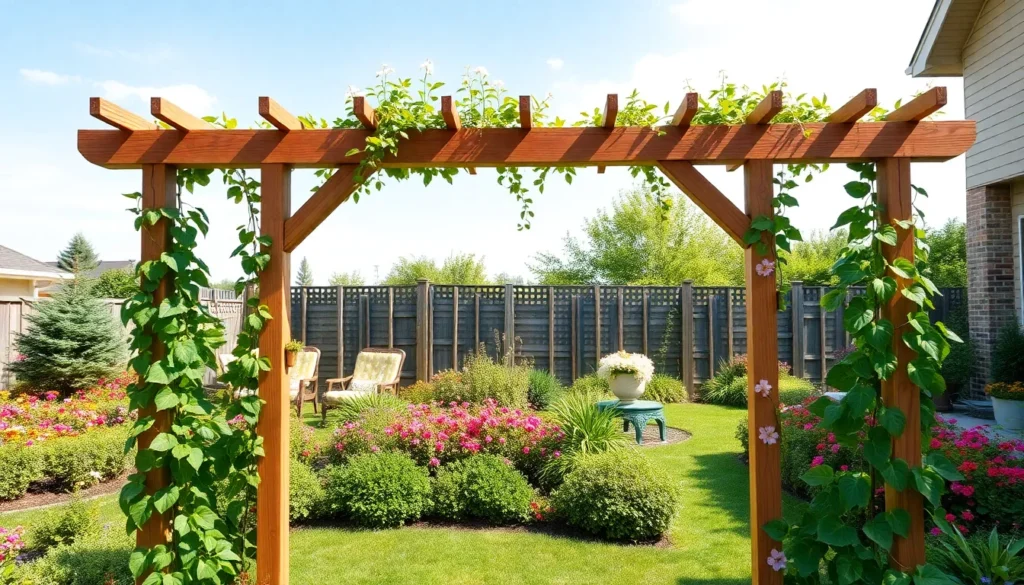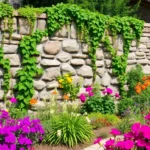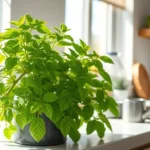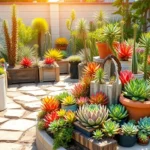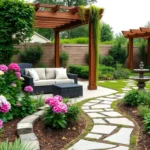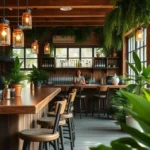Transform your garden into a vertical paradise with these stunning trellis ideas that’ll maximize your growing space and add serious style to your outdoor sanctuary. We’ve discovered that the right trellis doesn’t just support your climbing plants – it becomes a focal point that elevates your entire garden design.
Whether you’re working with a tiny balcony or sprawling backyard, we’ve curated the most innovative and practical trellis answers that gardeners are raving about. From rustic DIY projects using reclaimed materials to sleek modern designs that make a bold statement, these ideas will inspire you to think beyond traditional gardening boundaries.
Ready to create more growing space while adding architectural interest to your garden? We’re about to share ten game-changing trellis ideas that’ll have your neighbors asking for your secret. These aren’t just functional structures – they’re design elements that’ll transform how you view vertical gardening forever.
Classic Wooden A-Frame Trellis
We’ve found that the timeless A-frame trellis remains one of the most versatile and reliable structures for vertical gardening. This traditional design offers exceptional stability while creating an elegant backdrop for climbing plants like beans, peas, and flowering vines.
Traditional Cedar Construction
Cedar stands as our top choice for A-frame trellis construction due to its natural resistance to rot and insects. We recommend selecting premium cedar boards that measure 1×2 inches or 2×2 inches for optimal durability and structural integrity. Natural oils within cedar wood provide built-in protection against moisture and decay, eliminating the need for chemical treatments that could harm your plants.
Weather resistance makes cedar A-frame trellises perfect for year-round outdoor use without warping or splitting. We’ve observed that cedar structures maintain their attractive appearance for 10-15 years with minimal maintenance. The wood’s natural grain patterns and warm honey color complement any garden aesthetic, from cottage-style landscapes to modern minimalist designs.
Premium cedar costs more initially but delivers exceptional value through its longevity and low maintenance requirements. We suggest purchasing kiln-dried cedar lumber to prevent shrinkage and ensure dimensional stability during seasonal weather changes.
Easy DIY Assembly Options
Simple tools make A-frame trellis construction accessible for gardeners of all skill levels. We recommend gathering a drill, screws, measuring tape, and saw to complete your project in under two hours. Basic woodworking skills are sufficient to create a professional-looking structure that rivals store-bought alternatives.
Pre-cut lumber packages from home improvement stores eliminate the need for precise measuring and cutting. We’ve found that these kits typically include detailed instructions and all necessary hardware for straightforward assembly. Standard dimensions range from 4 feet to 8 feet in height, accommodating various garden spaces and plant requirements.
Modular designs allow you to create custom configurations by connecting multiple A-frame units together. We often recommend this approach for larger vegetable gardens where you need extended growing space for crops like cucumbers and squash. Hinged connections at the peak enable easy storage during winter months when the trellis isn’t needed.
Elegant Metal Obelisk Trellis
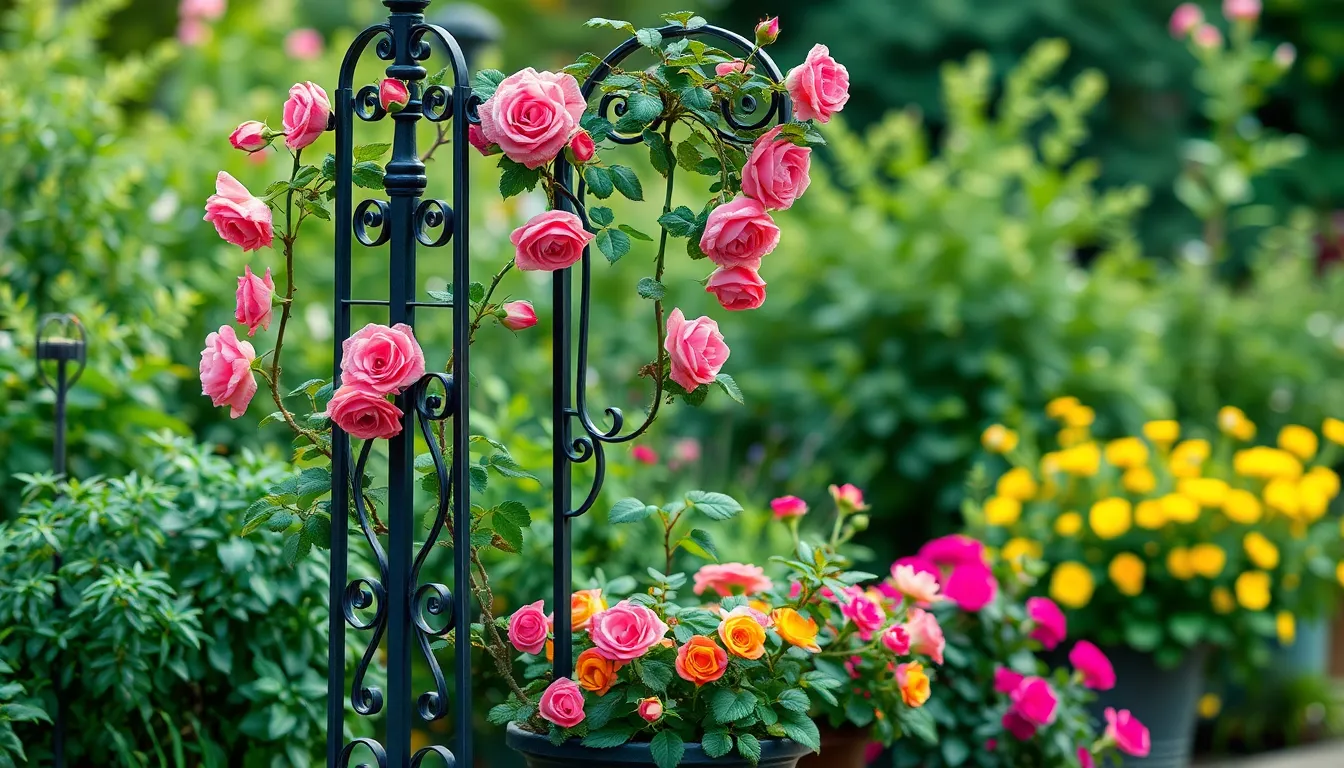
Metal obelisk trellises bring sophisticated elegance to container gardening while providing exceptional vertical support for climbing plants. These pyramid-shaped structures transform ordinary pots into stunning focal points that maximize growing space in compact areas.
Wrought Iron Decorative Designs
Wrought iron obelisk trellises offer timeless beauty with their ornate patterns and classic styling. We love how these decorative designs create perfect support systems for climbing roses, clematis, and other flowering vines that need sturdy frameworks to showcase their blooms.
Ornamental details in wrought iron trellises include scrollwork, leaf motifs, and geometric patterns that add architectural interest even when plants aren’t in season. The intricate metalwork serves dual purposes by providing multiple attachment points for plant tendrils while creating visual appeal in garden spaces.
Traditional craftsmanship shines through in hand-forged wrought iron pieces that feature unique character marks and subtle variations in design. These artisanal touches make each trellis a one-of-a-kind garden sculpture that enhances both formal and cottage-style landscapes.
Weather-Resistant Powder Coating
Powder coating technology extends the life of metal obelisk trellises by creating protective barriers against rust, corrosion, and UV damage. We recommend choosing trellises with high-quality powder coatings that can withstand temperature fluctuations and moisture exposure for years of reliable performance.
Color options in powder-coated finishes include classic black, bronze, green, and white that complement various garden color schemes. The coating process involves electrostatically applying dry powder particles that bond to metal surfaces when heated, creating seamless protection that won’t chip or peel like traditional paint.
Maintenance requirements for powder-coated obelisk trellises remain minimal, requiring only occasional cleaning with mild soap and water to maintain their appearance. The durable finish resists fading and maintains its original luster through multiple growing seasons, making these trellises excellent long-term investments for container gardens.
Space-Saving Wall-Mounted Trellis

Wall-mounted trellises offer the perfect solution for gardeners working with limited space, transforming vertical surfaces into productive growing areas.
Vertical Growing Answers
Wall-mounted trellis systems maximize your growing potential by utilizing every square inch of available vertical space. These trellises attach directly to walls or fences, creating sturdy support structures for climbing plants like sweet peas and climbing beans without taking up valuable ground space.
Installation becomes straightforward when you choose pre-drilled mounting brackets that secure directly into wall studs or masonry anchors. Most wall-mounted systems support up to 50 pounds of plant weight, making them suitable for heavy climbers like grape vines or squash plants.
Multiple mounting options include adjustable brackets that accommodate different wall angles and surfaces. You’ll find systems designed for brick walls, wooden fences, concrete surfaces, and even vinyl siding, ensuring compatibility with your existing garden infrastructure.
Modular panel designs allow you to create custom configurations by connecting multiple trellis sections. This flexibility lets you cover large wall areas or create interesting geometric patterns that serve both functional and decorative purposes.
Apartment and Small Garden Applications
Fan-shaped trellis panels excel in compact spaces by providing maximum growing surface while maintaining a narrow footprint against house walls. These panels create vertical interest and privacy screening, making them ideal for apartment patios and small urban gardens.
Balcony gardening benefits significantly from wall-mounted systems that don’t require floor space for support posts. You can grow fresh herbs, cherry tomatoes, and flowering vines without sacrificing precious patio area for entertaining or relaxation.
Rental-friendly options include removable mounting systems that use tension rods or clamp attachments, avoiding permanent modifications to walls. These answers protect security deposits while still providing excellent plant support for temporary growing situations.
Container integration works seamlessly with wall-mounted trellises, allowing you to position planters at the base while training climbers upward. This combination maximizes your growing capacity in minimal square footage, perfect for small garden spaces and urban environments.
Rustic Branch and Twig Trellis
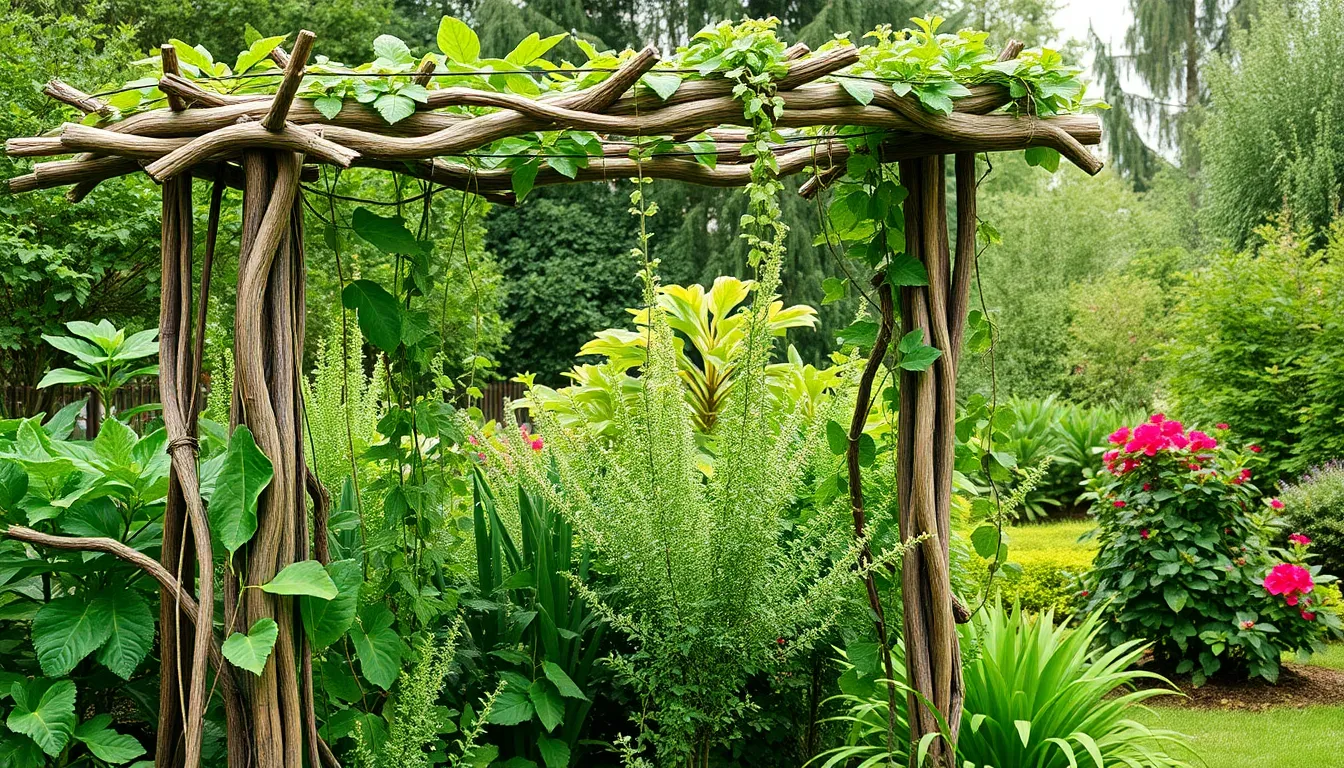
Creating a rustic branch and twig trellis brings organic beauty to your garden while supporting climbing plants with natural materials that blend seamlessly into outdoor surroundings.
Natural Material Sourcing
Bamboo offers the most sustainable choice for rustic trellis construction, growing up to 3 feet daily and regenerating without replanting. We recommend harvesting bamboo poles in late fall when moisture content is lowest for maximum durability.
Reclaimed wood provides character and environmental benefits by repurposing materials that would otherwise end up in landfills. Cedar fence pickets, barn wood, and weathered deck boards create unique trellis designs with built-in patina and texture.
Natural stone elements like fieldstone or river rock can anchor your twig trellis system while adding visual weight to the garden structure. Stones collected from your property or local quarries reduce transportation costs and connect your trellis to the industry.
Willow branches bend easily when fresh cut, making them perfect for weaving decorative patterns between vertical supports. We suggest cutting willow shoots in early spring when sap flow makes branches most pliable for intricate trellis work.
Eco-Friendly Construction Methods
Repurposing old ladders transforms discarded wooden stepladders into instant climbing structures without additional cutting or assembly. Simply position the ladder against a wall or fence, and climbing plants like morning glories will naturally weave through the rungs.
Pallet dismantling yields multiple lumber pieces perfect for creating custom trellis frames at zero material cost. Each standard pallet provides approximately 15 linear feet of usable wood once properly disassembled and denailed.
Window frame conversion gives vintage architectural elements new life as garden focal points while supporting lightweight climbers. Old casement windows work particularly well when hinged together to create accordion style expanding trellises.
Natural binding techniques using hemp rope, jute twine, or copper wire eliminate the need for metal fasteners and synthetic materials. These biodegradable connections actually strengthen over time as plant growth helps secure the joints naturally.
Modern Wire Grid Trellis
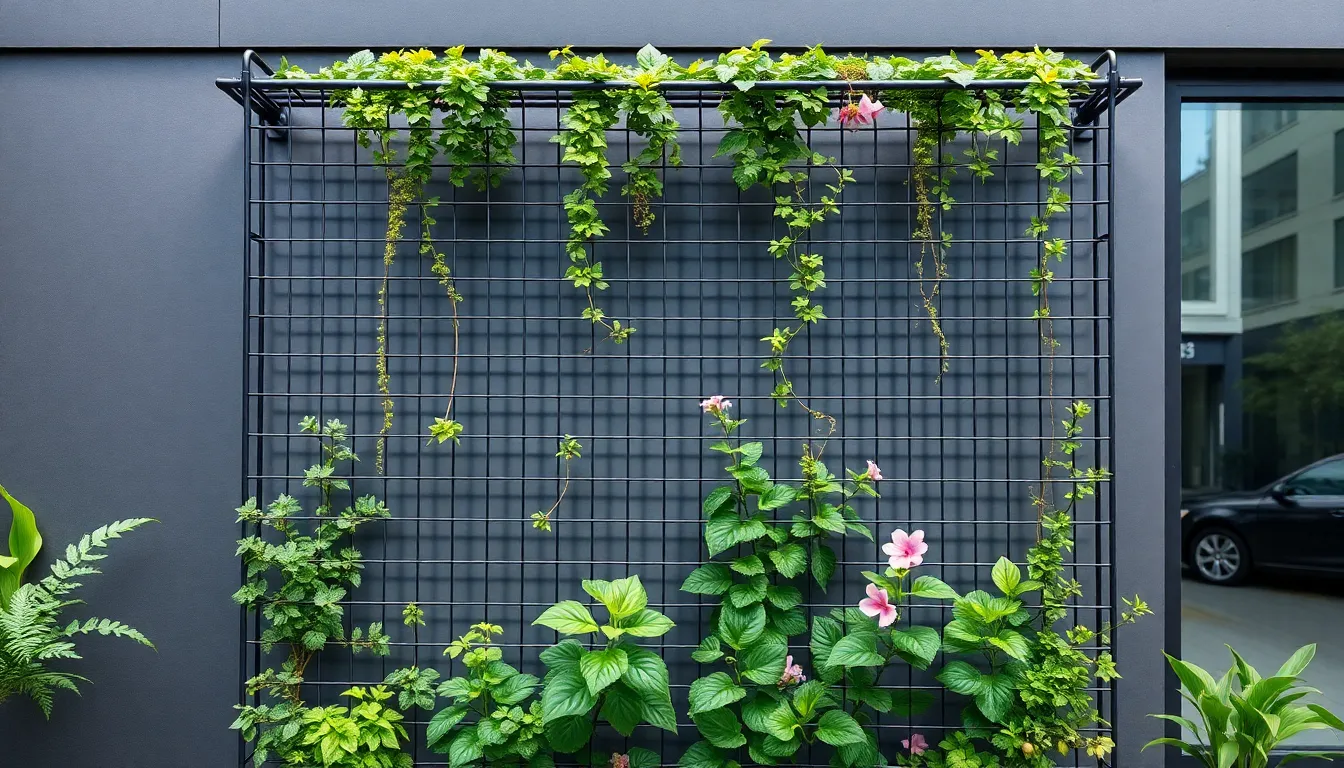
Wire grid systems create striking contemporary focal points that maximize growing space while maintaining sleek architectural appeal. These innovative structures transform vertical surfaces into productive growing areas with minimal visual bulk.
Clean Geometric Lines
Modern wire grid trellises embrace minimalist design principles through precise geometric patterns that complement contemporary garden aesthetics. Square and rectangular grid configurations offer systematic support for climbing plants while creating ordered visual structures that enhance modern landscapes.
We recommend choosing grids with uniform spacing between 4-6 inches to accommodate various plant types while maintaining design consistency. Stainless steel wire construction provides durability without overwhelming delicate foliage with heavy materials.
Installation becomes straightforward with pre-fabricated panels that mount directly to existing structures or standalone frames. Powder-coated finishes in black, white, or charcoal gray integrate seamlessly with modern architectural elements.
These geometric designs work exceptionally well in urban environments where clean lines echo surrounding buildings and hardscaping features. Plants trained on wire grids create living artwork that changes seasonally while maintaining structural definition.
Modular Panel Systems
Modular wire grid panels offer exceptional flexibility for gardeners who value adaptability in their vertical growing answers. Individual panels connect through simple clips or brackets, allowing configurations to expand or reconfigure based on seasonal needs.
Standard panel dimensions typically measure 2×4 feet or 3×3 feet, providing optimal coverage while remaining manageable for one-person installation. Connection hardware enables both horizontal and vertical panel linking for custom arrangements.
We’ve found that modular systems excel in rental properties where permanent installations aren’t feasible. Panels disassemble quickly for storage during winter months or relocation to new garden spaces.
Interchangeable components allow mixing different grid sizes within the same system, creating visual interest while accommodating plants with varying support requirements. Fine mesh sections support delicate vines, while wider grids suit robust climbers like cucumbers and squash.
Expansion capabilities make modular panels cost-effective long-term investments that grow with changing garden needs and available space.
Bamboo Teepee Trellis
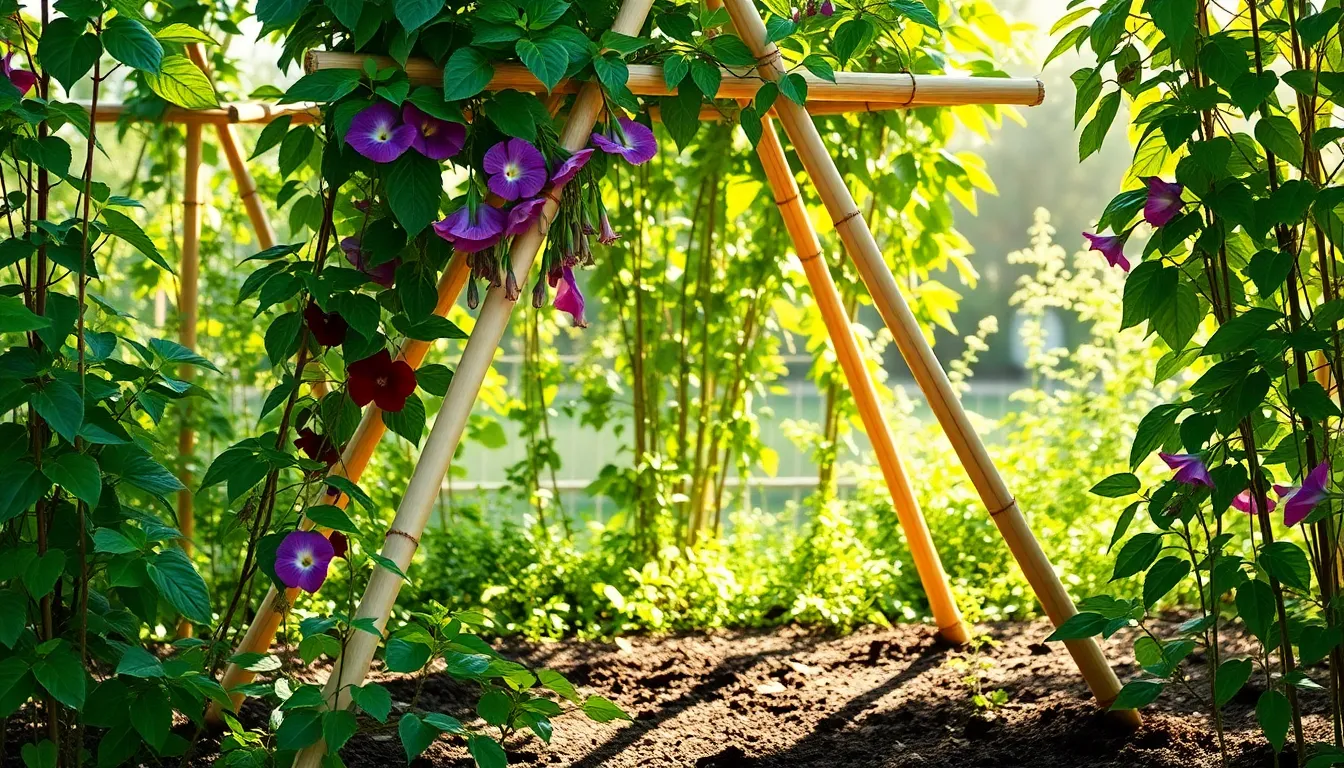
Bamboo teepee trellises offer an eco-friendly alternative that combines natural beauty with exceptional plant support functionality. These versatile structures create distinctive vertical growing spaces while maintaining environmental sustainability throughout your garden.
Sustainable Material Benefits
Bamboo stands out as one of nature’s most renewable resources, regenerating without replanting after harvest. We appreciate how this fast-growing grass species reaches maturity in just 3-5 years compared to traditional hardwoods that require decades. Environmental benefits extend beyond rapid growth, as bamboo produces 35% more oxygen than equivalent tree stands while absorbing significantly more carbon dioxide.
Natural resistance to pests and moisture makes bamboo an ideal outdoor material that withstands weather conditions without chemical treatments. Durability rivals that of traditional lumber while maintaining a lighter weight profile perfect for temporary installations. Biodegradable properties ensure that worn bamboo components can return to soil naturally, completing the sustainable gardening cycle.
Cost effectiveness becomes apparent when comparing bamboo trellis longevity against replacement frequency of synthetic alternatives. We find that quality bamboo structures maintain structural integrity for 5-7 years with minimal maintenance requirements.
Quick Setup and Portability
Assembly requires no specialized tools or hardware, making bamboo teepee installation accessible to gardeners of all skill levels. Three to four bamboo poles form the basic structure by simply gathering tops and securing with natural binding materials like jute or hemp rope. Setup typically completes within 15-20 minutes, allowing immediate planting around the base.
Lightweight construction enables easy relocation throughout growing seasons as garden layouts change or plant needs evolve. We recommend positioning teepees in spring for warm season climbers like beans and morning glories, then relocating for cool season crops in fall. Disassembly takes less than 5 minutes, with poles storing flat against walls or in sheds during off seasons.
Modular design allows multiple teepees to create attractive groupings or privacy screens without permanent industry modifications. Rental property compatibility makes bamboo teepees perfect for apartment balconies and temporary gardens where permanent structures aren’t permitted. Transport convenience means taking trellises to new locations requires minimal vehicle space compared to rigid metal or wooden alternatives.
Repurposed Ladder Trellis
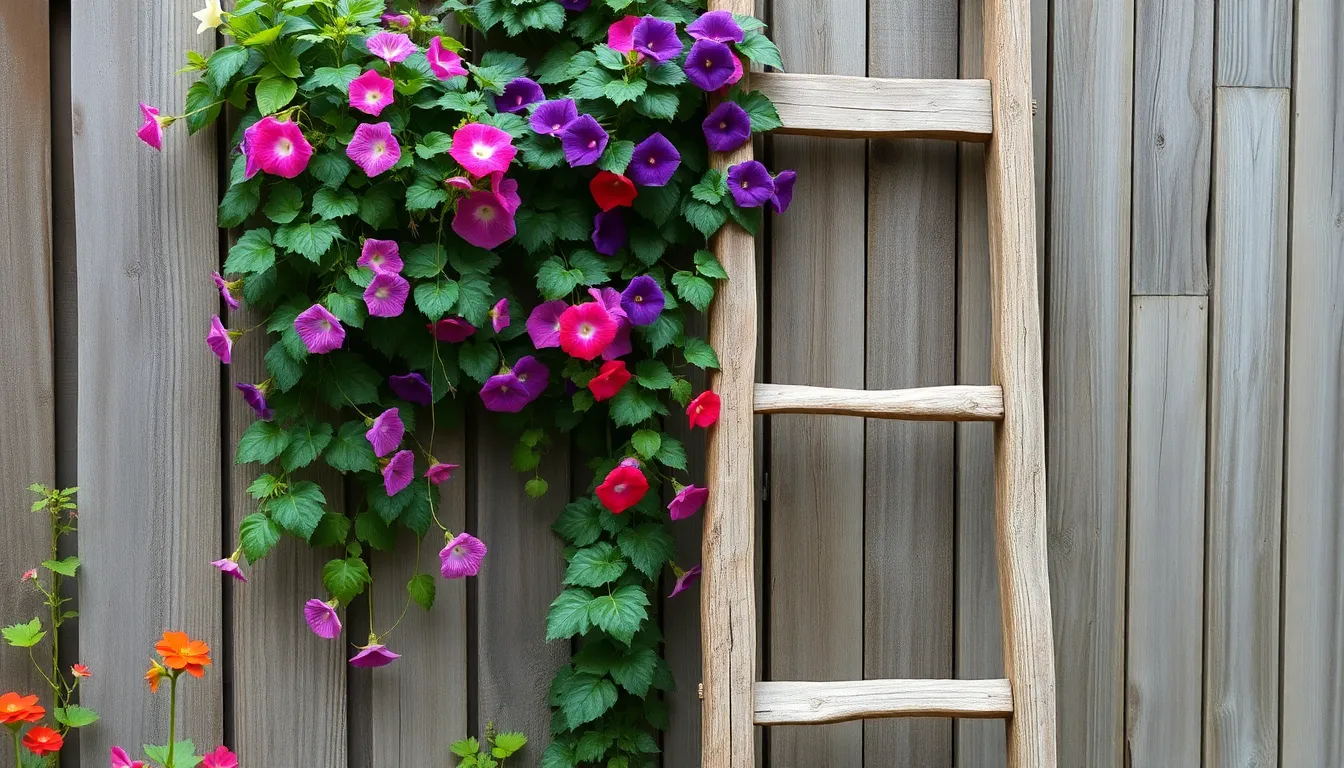
Transforming an old wooden ladder into a functional garden trellis creates an instant focal point that combines practicality with nostalgic appeal. We’ll explore how this simple upcycling project delivers both vintage character and budget-friendly garden answers.
Vintage Charm and Character
Old wooden ladders bring authentic farmhouse aesthetics to any garden space through their weathered textures and rustic appeal. Leaning a vintage ladder against walls or fences creates an instant backdrop for climbing plants like sweet peas and morning glories. We love how these repurposed pieces add instant history to newer garden spaces while maintaining their original character marks and paint patina.
Weathered rungs provide perfect attachment points for plant tendrils without requiring additional hardware or modifications. Antique ladders from estate sales and flea markets often feature unique construction details that modern pieces lack. We find that paint chips and wood staining only enhance their garden appeal rather than detract from functionality.
Different ladder heights create varied visual interest when arranged throughout garden beds. Tall stepladders work beautifully for vigorous climbers while shorter versions suit compact growing areas. We recommend grouping multiple vintage ladders to create ever-changing displays that guide the eye upward through your garden space.
Cost-Effective Upcycling Ideas
Repurposing existing ladders eliminates the expense of purchasing new trellis materials while keeping useful items out of landfills. We can transform damaged ladders that are no longer safe for climbing into perfectly functional plant supports. Missing rungs actually create larger openings for fuller plant growth and easier maintenance access.
Budget-conscious gardeners save significantly by scouring yard sales and thrift stores for ladder finds under $20. Cleaning and light repairs typically cost less than $10 in supplies while new comparable trellises often exceed $50. We suggest checking construction sites where contractors sometimes discard ladders with minor damage that gardeners can easily repair.
Simple modifications enhance ladder functionality without major investment or specialized tools. Adding horizontal wire between rungs creates additional support for lighter climbing plants. We recommend applying weather-resistant stain or paint to extend outdoor lifespan while maintaining the authentic vintage appearance that makes repurposed ladders so appealing.
Fan-Shaped Trellis Design
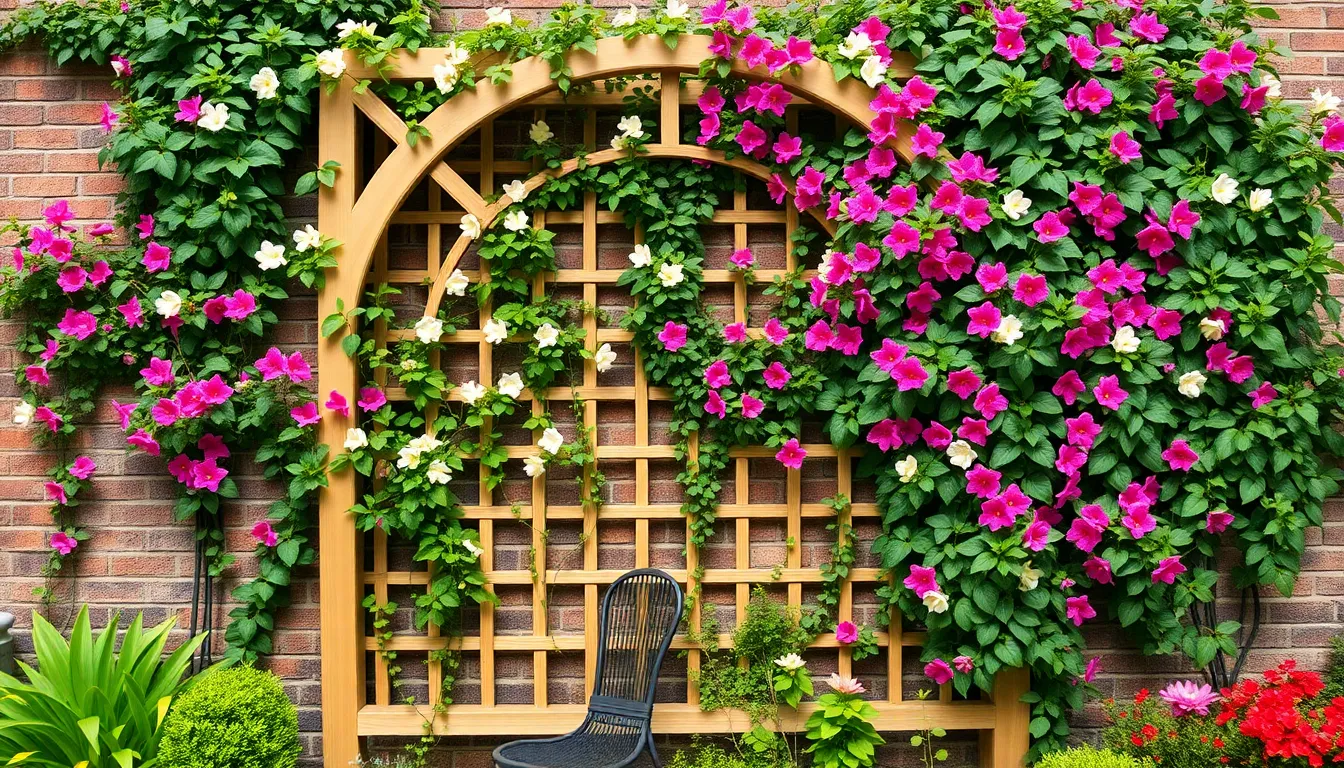
Fan-shaped trellises spread elegantly outward like an open fan, creating maximum growing surface while maintaining visual appeal in any garden space. We’ve found these designs particularly effective for showcasing climbing plants that benefit from spreading growth patterns.
Compact Corner Answers
Corner installations of fan-shaped trellises maximize underutilized garden spaces while creating stunning vertical displays. We recommend positioning these trellises at 45-degree angles to walls or fences, allowing vines to cascade naturally while filling awkward corner areas that often remain empty.
Small garden spaces benefit tremendously from corner-mounted fan designs because they provide substantial growing area without consuming valuable ground space. We’ve observed that these installations work exceptionally well for jasmine and clematis, which spread beautifully across the fan’s radiating supports.
Installation becomes straightforward when we use pre-drilled mounting brackets designed specifically for corner applications. Most corner fan trellises support up to 30 pounds of plant weight, making them suitable for medium-sized climbing varieties without requiring additional reinforcement.
Perfect Climbing Plant Support
Climbing plants thrive on fan-shaped trellises because the spreading design accommodates their natural growth patterns. We’ve found that jasmine responds particularly well to fan configurations, with its delicate vines weaving through the radiating supports to create dense, fragrant coverage.
Clematis varieties flourish on fan trellises due to the multiple attachment points available at various heights and angles. We recommend selecting clematis cultivars that bloom at different times throughout the season, ensuring continuous color and interest across the fan’s surface.
Support strength varies depending on construction materials, with wooden fan trellises typically supporting 25-40 pounds while metal versions handle up to 60 pounds of climbing plant weight. We suggest matching trellis capacity to your chosen plants’ mature weight to ensure long-term stability and plant health.
Vine training becomes intuitive with fan designs because the natural spreading pattern guides plant growth without excessive intervention. We’ve noticed that plants establish faster on fan trellises compared to linear designs, often reaching full coverage 2-3 weeks earlier in the growing season.
Arched Garden Trellis
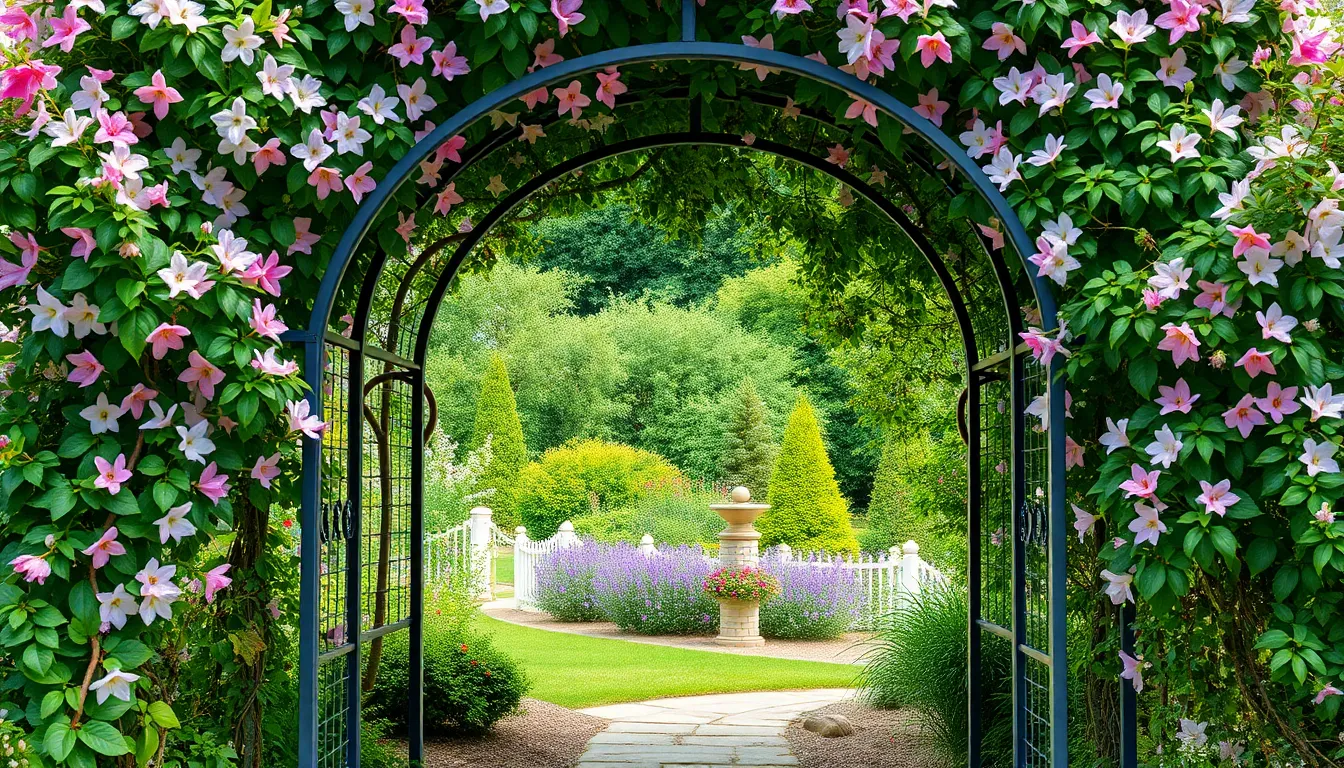
Arched garden trellises transform ordinary walkways into stunning garden passages that captivate visitors from the moment they enter. We’ve found these elegant structures create the perfect framework for establishing memorable entrance points while providing exceptional support for climbing plants.
Creating Dramatic Entrances
Positioning an arched trellis at garden entrances instantly elevates the visual impact of your outdoor space. We recommend installing these structures over pathways where guests naturally walk to create an immersive tunnel effect. Classic archway designs work beautifully for supporting vigorous climbers like clematis and jasmine that develop into living canopies.
Strategic placement enhances the architectural flow between different garden areas. We suggest positioning arched trellises at transition points where formal gardens meet casual spaces or where main paths connect to secluded seating areas. The natural framing effect draws attention forward while creating anticipation for what lies beyond.
Height considerations play a crucial role in entrance design effectiveness. We typically recommend arches measuring 8 feet tall and 6 feet wide to accommodate comfortable passage while providing adequate growing space. This sizing allows most climbing plants to develop fully without overwhelming the structure or creating maintenance challenges.
Weather resistant materials ensure your dramatic entrance maintains its appeal year round. We prefer powder coated steel or naturally rot resistant cedar for arch construction since these materials withstand outdoor elements while requiring minimal upkeep. Proper anchoring systems secure the structure against wind loads and support heavy plant growth.
Multiple Plant Training Options
Arched trellises accommodate diverse climbing plant varieties through their generous vertical and horizontal growing surfaces. We’ve successfully trained sweet peas along the lower sections while allowing jasmine to cascade from the top creating layered blooming displays. The curved structure provides natural attachment points at varying heights for different growth habits.
Companion planting strategies maximize the visual impact of arched supports throughout growing seasons. We recommend combining early spring climbers like clematis with late summer bloomers such as climbing roses for extended color displays. Fast growing annual vines can fill gaps while perennial climbers establish their permanent framework.
Training techniques vary based on plant characteristics and desired aesthetic outcomes. We guide twining plants like morning glories around vertical supports while securing climbing roses with soft ties at regular intervals. Vigorous growers benefit from initial pruning to encourage branching and fuller coverage.
Seasonal maintenance keeps multiple plant varieties healthy and attractive on shared trellis systems. We perform selective pruning in late winter to remove dead growth and shape established climbers before new growth begins. Regular monitoring during growing season allows for timely training adjustments and prevents plants from overwhelming each other.
Support modifications accommodate changing plant needs as gardens mature over time. We add horizontal wires or additional attachment points when existing climbers require more structure or when introducing new plant varieties. Flexible systems adapt to evolving garden designs while maintaining the dramatic entrance effect that makes arched trellises so appealing.
Living Willow Trellis
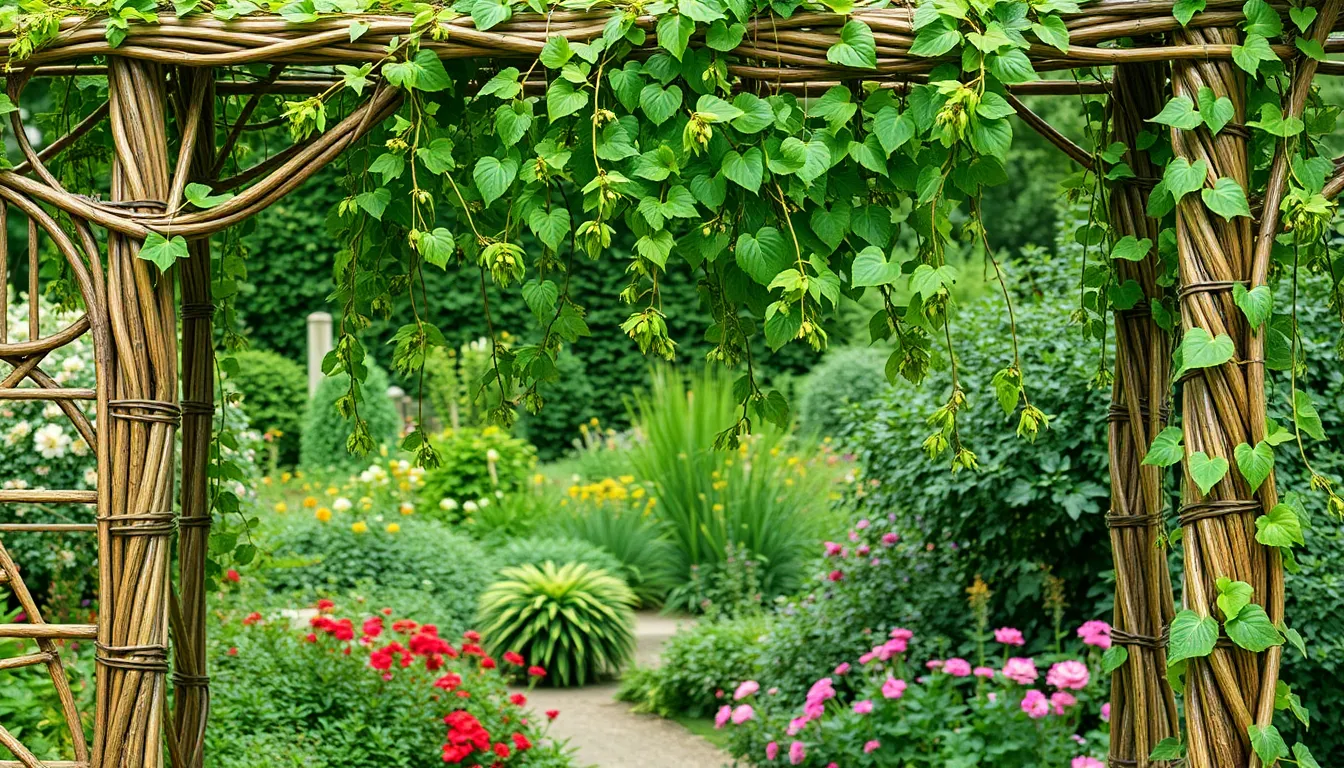
Living willow trellises represent the ultimate fusion of functionality and natural beauty in garden design. We’re weaving flexible willow branches to create a support structure that literally grows alongside our climbing plants.
Growing Your Own Support Structure
Weaving willow branches into trellis patterns creates a living support system that develops and strengthens over time. We position fresh willow cuttings in early spring when the sap is rising, ensuring maximum root development and successful establishment. These flexible branches bend easily into geometric patterns, diamond shapes, or curved designs that complement our garden’s aesthetic.
Starting with 6-8 foot willow rods, we create our framework by pushing the thicker ends 12-18 inches deep into prepared soil. The weaving process involves crossing branches at regular intervals, securing intersections with natural fiber ties until the willow establishes its own structure. Within 4-6 weeks, buds emerge along the woven framework, transforming our trellis into a living fence or privacy screen.
Fresh growth appears throughout the growing season, requiring periodic trimming to maintain the desired shape and prevent overgrowth. We harvest additional shoots annually, using them to repair sections or expand our living trellis system. This sustainable approach provides continuous material for garden improvements while maintaining the structure’s vitality.
Long-Term Garden Investment
Living willow trellises strengthen with age, developing robust root systems that anchor the structure permanently in place. We expect 15-20 years of reliable performance from established willow frameworks, making them exceptional long-term garden investments. The initial cost involves only purchasing willow rods, typically $2-3 per cutting, creating substantial savings compared to manufactured alternatives.
Maintenance requirements decrease significantly after the third growing season when root systems establish fully. We perform annual pruning to control growth and shape the structure, harvesting excess material for composting or additional trellis construction. These living supports adapt naturally to changing garden conditions, flexing with wind loads and expanding to accommodate growing plant masses.
The harmonious blend of trellis and climbing plants creates year-round visual interest, even during dormant seasons when the willow’s graceful framework remains visible. We appreciate how these structures improve with time, developing character and strength that manufactured trellises cannot match.
Conclusion
These ten trellis designs offer endless possibilities for transforming your garden into a thriving vertical paradise. Whether you’re drawn to the rustic charm of bamboo teepees or the sophisticated elegance of wrought iron obelisks each option brings unique benefits to your outdoor space.
We’ve shown you how the right trellis can maximize your growing potential while creating stunning focal points that enhance your garden’s overall design. From budget-friendly upcycled ladders to living willow structures that grow with your plants there’s a perfect solution for every gardener and every space.
Now it’s time to choose the trellis that speaks to your style and start creating the vertical garden of your dreams. Your climbing plants are waiting for the perfect support system to help them reach new heights.
Frequently Asked Questions
What is the best material for outdoor trellis construction?
Cedar is the top choice for wooden trellises due to its natural resistance to rot and insects. For metal options, powder-coated steel or wrought iron offer excellent durability and weather resistance. These materials can withstand outdoor conditions for 10-15 years with minimal maintenance, making them cost-effective long-term investments for any garden.
How much weight can a wall-mounted trellis support?
Most standard wall-mounted trellis systems can support up to 50 pounds when properly installed with pre-drilled mounting brackets. This capacity accommodates heavy climbing plants like grape vines and mature flowering vines. Always check the manufacturer’s specifications and ensure proper wall anchoring for maximum safety and plant support.
Are bamboo trellises environmentally friendly?
Yes, bamboo trellises are highly sustainable. Bamboo grows rapidly and regenerates without replanting, produces more oxygen than trees, and absorbs significant amounts of carbon dioxide. Additionally, bamboo is biodegradable, meaning worn components naturally return to the soil, making it an excellent eco-friendly choice for environmentally conscious gardeners.
Can I build a DIY trellis without advanced woodworking skills?
Absolutely! Many trellis designs, including A-frame and teepee styles, require only basic tools and simple assembly techniques. Most DIY projects can be completed in under two hours using pre-cut lumber packages. Modular designs and pre-drilled components make construction straightforward, even for beginners with minimal woodworking experience.
What plants work best with different trellis types?
A-frame trellises are perfect for beans, peas, and flowering vines. Obelisk trellises excel with climbing roses and clematis. Fan-shaped panels work well for herbs and spreading climbers like jasmine. Wire grids accommodate various plant types with uniform spacing. Choose your trellis based on your plants’ growth habits and weight requirements.
How do I maintain a living willow trellis?
Living willow trellises require annual pruning to maintain shape and health. Harvest excess material for composting or creating additional trellis sections. Water regularly during the first growing season to establish strong root systems. With proper care, these structures can last 15-20 years while continuously growing and adapting to your garden’s needs.
Are metal obelisk trellises suitable for container gardening?
Yes, metal obelisk trellises are ideal for containers. Their elegant design adds sophistication while providing excellent vertical support in limited spaces. Wrought iron and powder-coated options resist weather damage and require minimal maintenance. They’re particularly effective for balcony gardens and small spaces where ground installation isn’t possible.
Can trellis systems be moved or stored seasonally?
Many trellis designs offer portability. Bamboo teepees and modular wire grids can be easily disassembled and stored. A-frame trellises with hinged connections fold flat for off-season storage. This flexibility makes them perfect for rental properties or gardeners who like to reconfigure their layouts seasonally.

